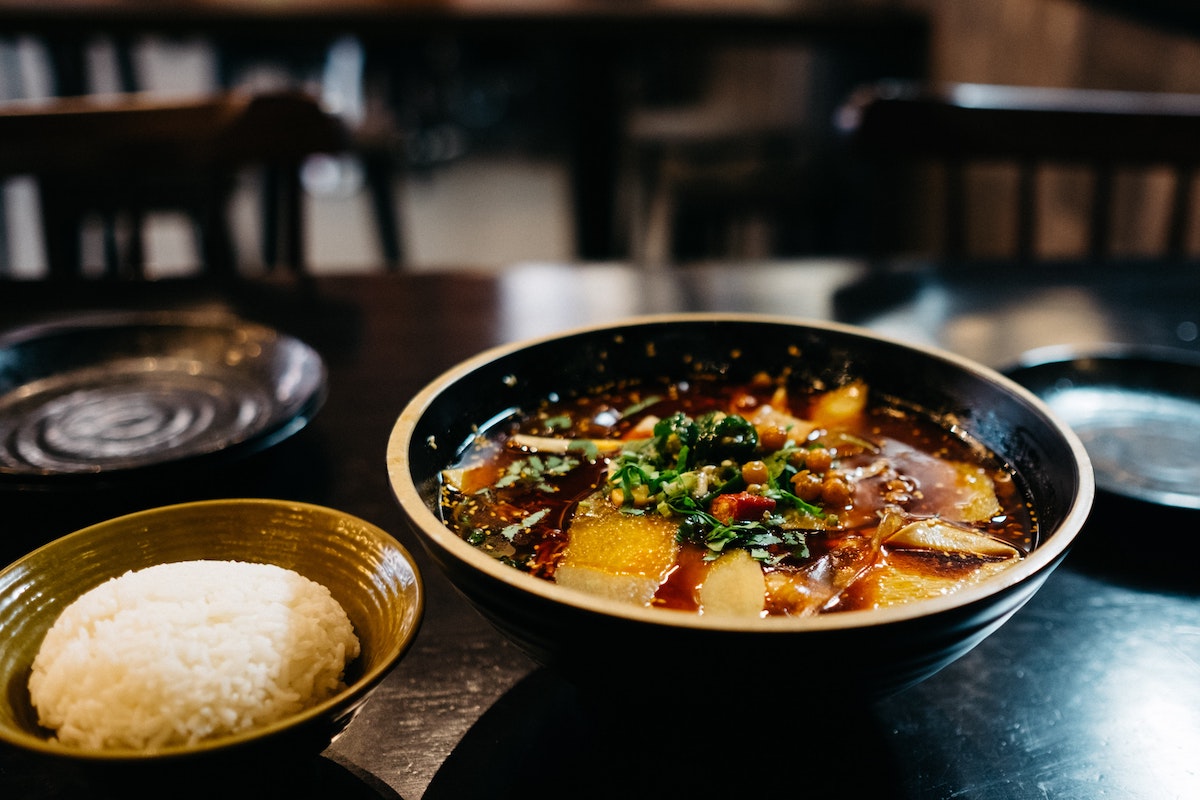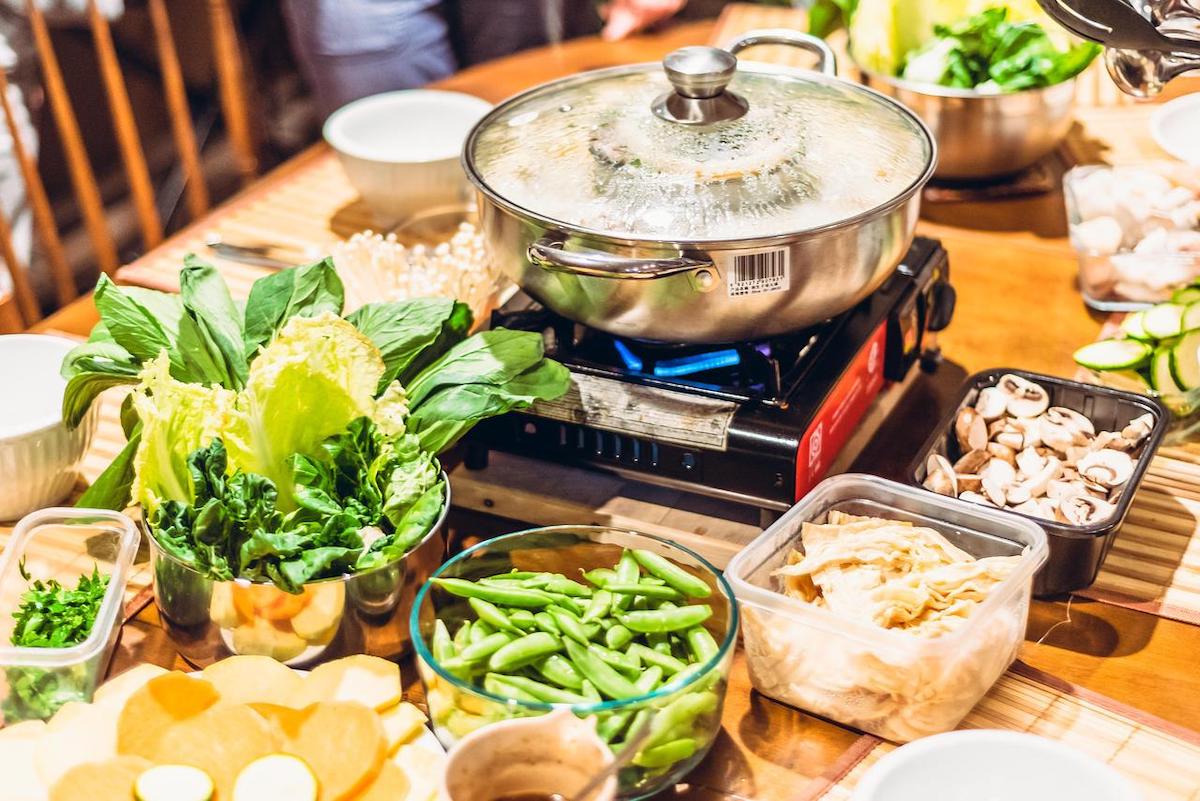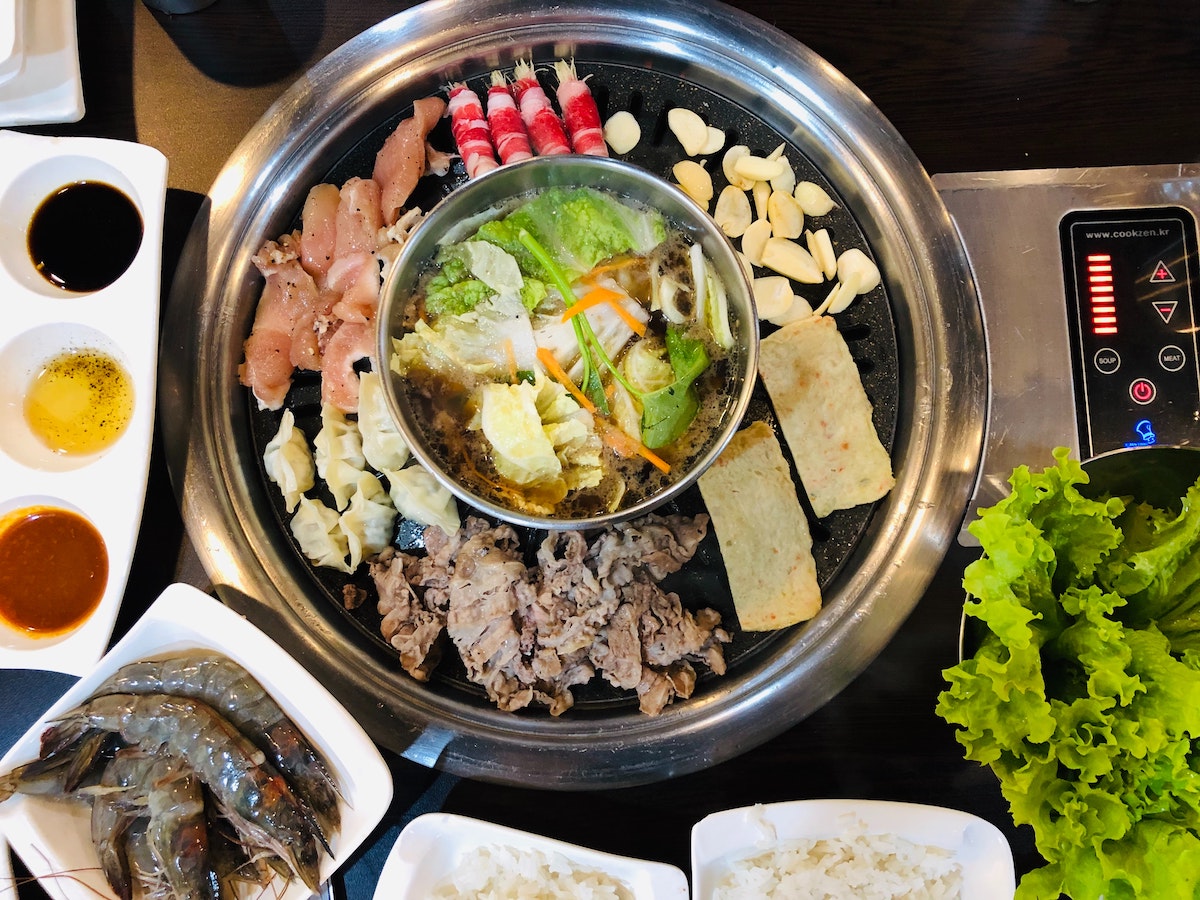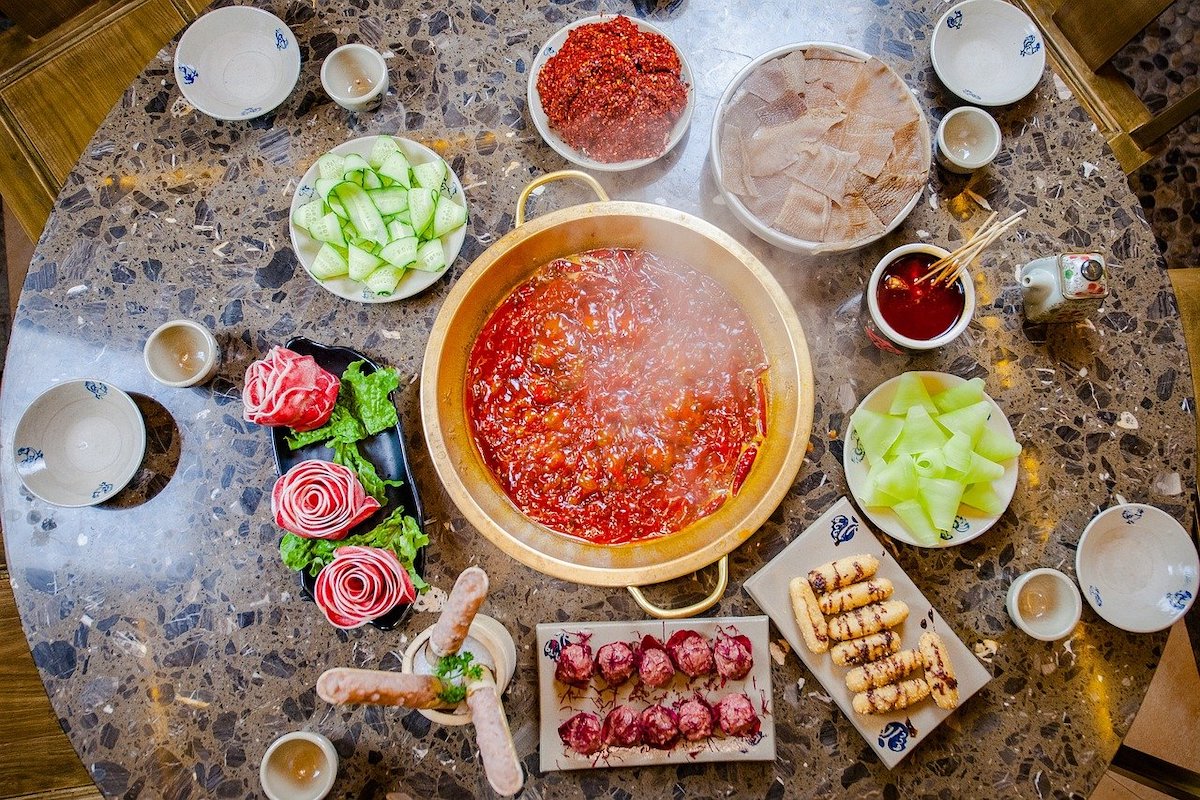
What Is Hot Pot? History, Styles, Where to Eat It, Recipes & More
By: Nick Callos
Skip to Section
Article Summary
Hot pot goes beyond food and lives as a social ritual built around flavor, community, and slow, satisfying conversation that stretches across cultures and centuries.
This guide breaks down the essentials of hot pot, from its 1,700-year history and regional variations across Asia to how you can enjoy it at home or find an authentic restaurant. You’ll learn what to expect at a hot pot meal, how to build your own setup, which ingredients work best, and what styles—from spicy Chongqing to creamy Cambodian—offer different flavor profiles. Whether you’re a curious beginner or a longtime fan, this article delivers everything you need to get started.
- Hot pot involves cooking raw ingredients in a simmering broth at the table and is meant to be shared with others.
- There are countless regional styles, including Sichuan, Mongolian, Japanese, and Thai, each with its own flavor base.
- It’s a cost-effective, communal way to eat, especially popular in winter or with larger groups of friends and family.
- You can recreate hot pot at home with the right gear, soup base, dipping sauces, and a variety of meats, vegetables, and noodles.
- Hot pot restaurants are common worldwide, from local spots to international chains like Haidilao—just be sure to check reviews before you go.
You don’t forget hot pot meals. Because it’s an interactive, sensory experience…
A common cooking method in China and throughout Asia, hot pot involves cooking food in a simmering pot of flavored broth. After cooking your meat, tofu, noodles, mushrooms, or veggies, you dip it in your sauce and seasonings of choice. Then, you eat.
Sounds good, right?
But hot pot is more than just delicious. It’s communal. Rarely eaten alone, hot pot is an experience shared with good friends and family. It’s a time to eat, talk, laugh, and enjoy life. I’ve literally had hot pot meals go for three hours without realizing it.
Here, we’ll go over everything you need to know about hot pot, including:
- What is hot pot?
- The history of hot pot
- How to eat hot pot
- Hot pot recipes for home
- Where to find a good hot pot restaurant
What is Hot Pot?
So, what is hot pot exactly?
Hot pot is best defined as both a dish and an experience. Hot pot is a simmering pot of soup stock heated on an electric range, butane gas range, or induction burner. Diners directly boil raw and uncooked foods in the pot. Some common hot pot foods include:
- Thinly sliced beef
- Squid
- Fish fillets
- Head-on shrimp
- Tofu sheets
- Vermicelli
- Quail eggs
- Napa cabbage
- Bean sprouts
- Oyster mushrooms
- Leafy greens
When eating hot pot, diners gather around a table, each with their own plate and bowl that includes a dipping sauce and seasonings. The food sizzles in the flavor-filled pot and you grab what you want with chopsticks or a large skimmer spoon. When it comes to the dipping sauce, you have many options. I prefer sesame seed oil, cilantro, and garlic (common in Sichuan, China). But you can mix and match among ingredients that include oyster sauce, crushed peanuts, chili garlic sauce, chopped green onions, salt, and more.
Since hot pot is a communal meal that involves sharing a pot, it’s an incredibly social meal. Most folks spend the meal not only eating, but also catching up with family members and friends. Hot pot can be eaten any time of the year, but many folks like to enjoy it in the winter, as the simmering pot and communal nature of the meal create a warm, relaxed atmosphere.
Chinese hot pot may be most familiar to many folks in the West. Hot pot is especially popular in the city of Chongqing and throughout Sichuan, a province in China known for foods such as Mapo Tofu and Kung Pao Chicken. Chongqing hot pot is famous for having Sichuan peppercorns, which provides a numbingly spicy effect.
In other areas of China, you’ll find a different flavor. Travel south of Sichuan to the province of Yunnan, and you’ll discover a much more sour flavor. Cantonese hot pot has a lot more seafood options (given the location). In Jiangsu, the fragrant chrysanthemum tastes dominate. And in Beijing, simplicity shines, with ginger and scallions providing flavor.
Hot Pot Variations
Hot pot variations extend beyond China to much of Asia, each region adding its own unique twist to the traditional dish. Among these, the Mongolian hot pot stands out as perhaps the most well-known version. Traditionally made with mutton, this particular style of hot pot is deeply rooted in history, tracing its origins back to approximately a thousand years ago. During this time, soldiers relied on it for sustenance and warmth, making it an essential part of their diet and survival in harsh conditions.
Other hot pot styles in Asia include:
- Shabu Shabu in Japan: This is a traditional Japanese hot pot dish where you gently cook thinly sliced meat and fresh vegetables in a flavorful soup stock known as Kombu Dashi, which enhances the natural taste of the ingredients.
- Cambodian Hot Pot: Commonly referred to as Yao Hon, this traditional Cambodian hot pot is distinctive for incorporating creamy coconut milk into its rich and flavorful soup base, which sets it apart from other types of hot pots.
- Thai Hot Pot: Commonly referred to as Thai Suki, this popular Thai dish features a flavorful chicken broth infused with the aromatic essence of lemongrass, giving a unique twist to the traditional hot pot experience.
- Vietnamese Hot Pot: In Vietnam, hot pot is called lẩu and the dish infuses lots of classic Vietnamese flavors and ingredients, such as fragrant kaffir lime leaves, spicy red chili, and aromatic citronella. Lẩu is a versatile dish with many variations, one of which includes a salted fish hot pot that serves up a distinct taste experience.
- Korean Beef Stew: This Korean-style hot pot dish, known as Bulgogi Jeongol, features a rich and flavorful soup stock combined with tender glass noodles. It is further enhanced by a variety of fresh vegetables and succulent marinated bulgogi, creating a harmonious blend of textures and tastes that is both comforting and satisfying.
The History of Hot Pot

Image by Vlad Vasnetsov from Pixabay
Also written as hotpot, hot pot has been around for at least 1,700 years, according to scholars such as Richard Zhang, Director of the Sichuan Cuisine Museum. Pots used for hot pot meals date back to the Three Kingdoms Era, which spanned from 220—280 AD.
However, some experts believe that the “hot pot” or “hotpot” of those times was mainly a cooking mechanism. The pot was particularly popular in the north, where cold winters necessitated heat and warm meals. These experts say hot pot as we know it today didn’t appear until the 14th century, when emperors from the Ming and then Qing dynasties fell in love with hot pot.
From there, the different variations that we see today emerged. And in the early 20th century, hot pot restaurants started to open in cities like Chongqing. Today, the dish has achieved worldwide fame. Travel to any major city, and you’ll find a hot pot restaurant.
How to Eat Hot Pot
If you’ve never had hot pot, there’s no better time than now to try it! Generally, it’s a casual experience to be enjoyed with friends and you just pick foods out of the pot as you wish (once cooked, of course).
There are only a few things to keep in mind while eating:
- Cook your ingredients gradually (and not all at once): I like to start with protein, such as beef and tofu, before moving on to veggies, potatoes, and noodles.
- Share with others: Hot pot is very communal, so share the garlic, help others grab food, do cheers if you’re drinking, and offer to pay the check (just kidding, kind of).
- Using a soup scoop is easier and safer: If you don’t want to sift through a boiling pot with chopsticks, use a soup scoop or some kind of skimmer. You can use your chopsticks if you want, though.
- Understand the cooking times of foods: It might take mushrooms 5—10 minutes to cook, while thin slices of lamb can be done within a minute! If you’re out at a restaurant, some menu items, such as quail eggs, are already cooked and just need to be heated in the pot.
- Certain foods soak up the spices better: If you’re eating Chongqing-style hot pot, know that leafy greens, cauliflower, and tofu blocks will get very spicy after simmering in the pot for a little while.
- Use a dipping sauce: It’s a great way to tailor the flavor to your palate. Like garlic? Put a bunch in your bowl. Prefer oyster sauce? Go with that instead of chili oil or sesame seed oil.
- Use a tomato- or mushroom-based broth if you’re a vegetarian: The traditional Sichuan hot pot uses a beef-based soup base. If you don’t eat meat, go with a tomato- or mushroom-based broth. Many restaurants have this option or something similar if dining out.
As hot pot is a shared meal, it’s usually cost-effective. For instance, if you eat hot pot in New York City with 4—8 people, you’ll probably spend around $20 per person for food (unless it’s upscale).
Hot Pot Recipes for Home

Photo by Reimond de Zuñiga on Unsplash
For a successful meal, having the right hot pot equipment is essential. You need:
- A burner: The type of electric or butane gas stove you would take camping works fine.
- An actual hot pot: You can’t forget about the hot pot (or hotpot).
- Accessories: This includes chopsticks, mini tongs, strainers, spoons, and shallow bowls for dipping sauce and eating.
Note: You can buy these a pot and cooktop together. For example, this induction cooker cooktop from Rosewill works well for hot pot meals.
Also, some of your friends may not like spicy food. If that’s the case, buy a hot pot with a separator. Half the pot can have spicy flavorings while the other half can be milder.
Speaking of the soup base, if you want spicy, Chongqing-style hot pot, go for one of the following:
For a soup base a little less spicy, go with one of the plain broths from Little Sheep. For convenience, Little Sheep offers packs of hot and plain together.
Now, when it comes to the food, know there is no set recipe for hot pot at home. Variety and balance are crucial. For example, if eating with a group of 4, you could order:
- 2 meat items, such as pork balls and thinly sliced beef
- 2 fish and seafood items, such as fish fillet and squid
- 4 veggie dishes, such as cabbage, cauliflower, lotus root, and spinach
- 2 non-meat items such as tofu and some kind of mushroom
- 2 kinds of noodle, such as vermicelli and udon noodles
Each of these dishes should be cut and fully prepped. Before eating, set the plates near the table.
Dipping sauces can be customized as well. As the dipping base, offer sesame seed oil, oyster sauce, soy sauce, Chinese barbecue sauce, and a peanut sauce. Additional flavorings and seasonings should include chopped scallions, garlic, cilantro, and peanuts, as well as crushed chilis, white pepper, and salt.
As you eat, pay attention to the water level in the hot pot. Add water as needed.
Where to Find a Good Hot Pot Restaurant
If you’re in a city in China, you can probably walk outside and find a hot pot restaurant within a few minutes, especially if you’re in a place like Chengdu or Chongqing. If you’re somewhere else, you can probably still find hot pot eateries.
For instance, in most cities in America, there are some surprisingly authentic hot pot options. A simple Google search will show you that. Cities like New York City, San Francisco, and Toronto have high-quality hot pot that compares to what you’ll find within China.
Even chain hot pot restaurants have been popping up all over the world over the last few decades. Hailidao, a famous hot pot chain, has locations ranging from Japan to Australia to the United Kingdom.
Before deciding on a place, do read reviews, check with friends, and see what folks who know hot pot say. If a spot is good, there’ll be plenty of good hype around it.
Here’s to Your Hot Pot Adventures!
We hope you’ve enjoyed learning about hot pot (or hotpot). Few meals offer the experience hot pot does, and it’s definitely something you should enjoy with friends if you haven’t already. Because after that first time having hot pot, you’ll be planning the next one right away.
For more articles about food, check out our foodie travel guides. From the best spicy dishes to the history of ceviche, we cover it all.
About the Author
Nick Callos has always had a passion for reading, writing, and discovering the new and unknown. Originally from Cincinnati, Ohio, Nick holds a Bachelor’s Degree in English from Boston College. He currently splits his time between his hometown, Chengdu, China, and the open road. A full-time travel writer, Nick hopes his work can inspire others to explore the world more deeply and enjoy the digital nomad lifestyle.Featured image via Unsplash.
Information published on this website and across our networks can change over time. Stories and recommendations reflect the subjective opinions of our writers. You should consult multiple sources to ensure you have the most current, safe, and correct details for your own research and plans.
Frayed Passport is a participant in the Amazon Associates Program, an affiliate advertising program designed to provide a means for sites to earn advertising fees by advertising and linking to Amazon.com. We also may share links to other affiliates and sponsors in articles across our website.





